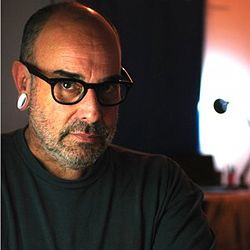Loading AI tools
Israeli visual artist, sculptor, musician and film maker From Wikipedia, the free encyclopedia
Uri Katzenstein (Hebrew: אורי קצנשטיין; February 17, 1951 – August 24, 2018)[1] was an Israeli visual artist, sculptor, musician, builder of musical instruments and sound machines, and film maker.[2]
Professor Uri Katzenstein | |
|---|---|
אורי קצנשטיין | |
 Photo of Uri Katzenstein (Photographer: Avi Levin) | |
| Born | February 17, 1951 Tel Aviv, Israel |
| Died | August 24, 2018 (aged 67) |
| Nationality | Israeli |
| Education | San Francisco Art Institute |
| Known for | Sculpting, visual art, music and film |
| Notable work | "Patʹshegen" (1993) "Family of Brothers" (2000) "Backyard" (2015) |
| Movement | Avant-garde |
| Website | urikatzenstein |
Uri was born in Tel Aviv, Israel in 1951 and was the only child of German-born parents who moved to Mandatory Palestine before the Holocaust. In his youth, he played music and joined several Rock bands. In 1969, he joined the Israeli Defense Forces and fought in the Yom Kippur War as a medic.[3][4][5][6] During the late 1970s of the 20th century, Uri studied at the San Francisco Art Institute and after receiving his MFA moved to New York City where he lived and worked throughout the 1980s. His early works, starting from the late 1970s, involved different avant-garde media Exhibits, music, performance, video and sound art. In the mid-1990s of the 20th century, he began creating sculptured Figurines, in addition to objects and sound machines which were all merged and composed as one time-based viewing / listening events.[3][7]
After returning to Israel, he and Noam HaLevi produced the show "Midas". In 1993 he took part in the rock opera "Samara" by Hillel Mittelpunkt and the band Nikmat HaTraktor. In 1999, he issued a music album, along with Ohad Fishof, entitled "Skin O Daayba", which served as the basis for a musical performance. In 2001, he produced the show "Home" along with Renana Raz and Ohad Fishof. In the early 2000s he began to create video art consisting of surreal events while emphasizing subject matter of personal identity. Among his notable works are Patʹshegen (1993) and "Family of Brothers" (Mishpachat ha-Achim; 2000). His early performance work was regularly presented at such legendary performance venues as The Kitchen, No-Se-No, 8BC and Danceteria. His work in sculpture, , video and installation have been exhibited in museums including the Russian State Museum (St. Petersburg), The Chelsea Art Museum (New York City), Kunsthalle Dusseldorf, The Israel Museum, Duke University Museum of Art (North Carolina). Katzenstein participated in the Sao-Paulo Biennale (1991), the Venice Biennale (2001), the Buenos Aires Biennale (first prize, 2002), and the 9th Istanbul Biennale (2005). His performance work appeared in theatres and galleries in London, Berlin, San Francisco, Cardiff (Wales), Santiago de Compostela (Spain), New York City, and Tel Aviv.[3][8]
From 2003 until his death Uri Katzenstein lectured in the Department of Fine Arts of the Faculty of Humanities at the University of Haifa.[9][10]
Uri Katzenstein died on August 24, 2018, following a stroke.[11]
In September 2018, following his death, an exhibition which he was working on, entitled "The Institute of Ongoing Things" opened at the Jewish Historical Museum in Amsterdam. In January 2019, another art exhibition which he was working on entitled "You Never Know" opened at the ZAZ10TS in Times Square in New York City.[12]
In October 2021, more than three years after his death, an exhibition focusing on the art of Uri Katzenstein entitled "Who Comes After Us?" opened at Holon’s Mediatheque and Center for Digital Art.[13]
Katzenstein has received the following awards:[3]
Seamless Wikipedia browsing. On steroids.
Every time you click a link to Wikipedia, Wiktionary or Wikiquote in your browser's search results, it will show the modern Wikiwand interface.
Wikiwand extension is a five stars, simple, with minimum permission required to keep your browsing private, safe and transparent.